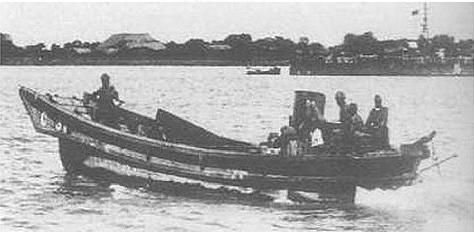![]() The Pacific War Online Encyclopedia
The Pacific War Online Encyclopedia
|
| Previous: Daigo Tadashige | Table of Contents | Next: Dairen |

| Tonnage |
10.5 tons light displacement |
| Dimensions |
47'10" by 11'0" by 2'6" 14.58m by 3.35m by 0.76m |
| Maximum speed | About 8 knots |
| Complement |
12 |
| Armament |
2 light machine guns or 2-3 25mm/60 AA
guns |
| Machinery |
1-shaft kerosene (80 shp) |
| Range |
100 nautical miles (190km) at 7.5 knots 50 nautical miles (90 km) at 8.5 knots |
| Cargo |
1 Type 95 7.4 ton tank or 70 men or 10 tons cargo |
The Daihatsu ("large motorized boat") or 14m landing
craft, known in Army service as either the Type A or the Type
LB-D, resembled the Allied
LCVP, with a bow ramp that
was lowered on hitting the beach. However, the Daihatsu was less boxy than
an LCVP, giving it better seakeeping. It had a welded steel hull. The postwar
U.S. Naval Technical Mission reported that it was powered by an
80-horsepower kerosene engine, but other intelligence sources
suggest that there was little standardization on the power plant,
and diesel and gasoline engines of 60 to 80 horsepower were also
used. The Daihatsu was often field-modified to carry
addition weapons of up to 37mm caliber, and the crew compartment
was often protected with improvised armor.
Though originally developed for the Army, the Navy adopted the Daihatsu
as its principal landing craft and ordered 3229 units. It is not
known how many were actually completed (though at least 40 were
built in 1942), but the craft were so frequently encountered by
Allied forces in the South Pacific, where they played an important
logistical role, that actual
construction must have been closer to the figure of 3229 than 40.
Postwar the U.S. Navy
Technical Mission determined that 85% of all Japanese landing
craft were of this type.
Allied destroyers had a
difficult time intercepting Daihatsu
traffic in the Solomons.
The improvised armor kept 40mm fire from
being fully effective, and the landing craft were difficult
targets for 5" guns
because of their small size and high maneuverability.
References
"Handbook on Japanese Military Forces" (1944-9; accessed 2017-7-15)
Jentschura, Jung, and Mickel (1977)
The Pacific War Online Encyclopedia © 2007-2009, 2016-2917 by Kent G. Budge. Index